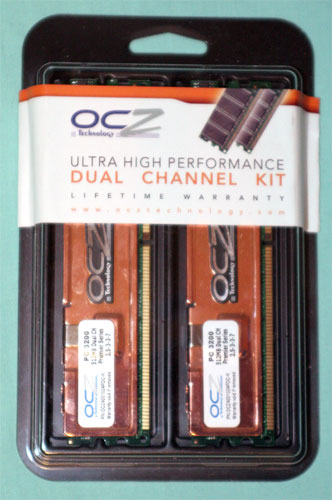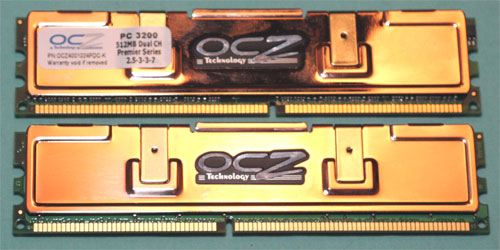Value RAM Roundup: Computing On a Budget
by Wesley Fink on April 11, 2005 4:26 PM EST- Posted in
- Memory
OCZ PC3200 Premier
In the past two years, OCZ has moved from relative obscurity to becoming one of the most widely recognized names in enthusiast products. Today, OCZ markets power supplies, heat sinks, memory voltage boosters, and thermal compounds, but OCZ is still best known for their enthusiast memory. Recently, OCZ has also been quite innovative in new product introductions, including products like our current RAM Speed champ, OCZ VX, which requires a very non-standard 3.5 to 3.6V to really shine.What many forget is that like Corsair, Kingston, Mushkin, and other full-line memory companies, OCZ has a very large line of value products. The Premier Series is a Value line, and the PC3200 Premier is a typical Value product, with a web selling price as low as $121 at mWave.


Specifications
OCZ rates their PC3200 Premier at the more aggressive CAS 2.5 timings at DDR400 and stock voltage.| OCZ PC3200 Premier (DDR400) Memory Specifications | |
| Number of DIMMs & Banks | 2 DS |
| DIMM Size Total Memory |
512 MB 1GB |
| Rated Timings | 2.5-3-3-7 at DDR400 |
| SPD (Auto) Timings | 2.5-3-3-7 |
| Rated Voltage | 2.6V |
Test Results
The OCZ PC3200 Premier is the first Value RAM we have tested that reaches DDR480, our next test point on the 2.4GHz ratios. Our samples actually booted as high as DDR500, but memtest86, Super Pi and games were not stable beyond DDR480, regardless of voltage.| OCZ PC3200 Premier (DDR400) - 2 x 512Mb Double-Bank | |||||||
| CPU Ratio at 2.4GHz | Memory Speed |
Memory Timings & Voltage |
Quake3 fps |
Sandra UNBuffered | Sandra Standard Buffered |
Super PI 2M places (time in sec) |
Wolfenstein - Radar - Enemy Territory fps |
| 12x200 | 400 DDR | 2.5-3-2-6 2.6V 1T |
535.0 | INT 2637 FLT 2826 |
INT 6072 FLT 6025 |
83 | 112.4 |
| 11x218 | 436 DDR | 2.5-3-3-6 2.7V 1T |
538.5 | INT 2803 FLT 2969 |
INT 6481 FLT 6410 |
82 | 113.0 |
| 10x240 | 480 DDR | 2.5-3-3-6 2.9V 1T |
546.6 | INT 2901 FLT 3136 |
INT 6708 FLT 6626 |
81 | 114.7 |
| 11x240 (2.64GHz) |
Highest CPU/Mem Performance | 2.5-3-3-6 2.9V 1T |
586.0 | INT 2976 FLT 3214 |
INT 7083 FLT 7007 |
75 | 124.1 |
The Premier actually did a bit better than specified at DDR400 with stable 2.5-3-2-6 timings. It is also worth noting that Premier was stable with CAS 2.5 timings all the way to the memory speed limit of DDR480. This is particularly outstanding performance for a memory that actually sells for $121.
Aida 32 is now available as Everest Home Edition, a free download from www.lavalys.com. Everest has been very useful in measuring read/write performance and memory latency.
| OCZ PC3200 Premier (DDR400) 2x512Mb Double-Bank Everest 1.51 |
|||||
| CPU Ratio at 2.4GHz | Memory Speed | Memory Timings & Voltage |
Everest READ MB/s |
Everest WRITE MB/s |
Everest Latency ns |
| 12x200 | 400 DDR | 2.5-3-2-6 2.6V 1T |
5795 | 1948 | 47.1 |
| 11x218 | 436 DDR | 2.5-3-3-6 2.7V 1T |
6122 | 1998 | 44.6 |
| 10x240 | 480 DDR | 2.5-3-3-6 2.9V 1T |
6661 | 2217 | 44.3 |
| 11x240 (2.64GHz) |
Highest CPU/Mem Performance | 2.5-3-3-6 2.9V 1T |
6668 | 2710 | 40.3 |
With OCZ Premier covering a broader range of memory speeds from 400 to 480, there is more potential to see the true impact of memory speed on performance. With memory timings at a consistent 2.5-3-3 and CPU speed at a constant 2.4GHz, any performance deltas are the result of true performance differences. As we move from 400 to 480 - a 20% speed increase - memory read improves by 15%, write improves by almost 40%, and latency drops by about 17%.
However, these improvements in synthetic memory benchmarks are not reflected by similar improvements in benchmarks with real games. Improving memory speed by 20% - from 400 to 480 - at the same CPU speed improves gaming performance by just 2% to 3%. Clearly, we are getting a better performance increase than this in real-world performance with faster CPU speed. You can see this in the 10% CPU speed increase from 10x240 to 11x240 at the same memory timings. This 10% CPU Speed increase improves gaming FPS by about 8%.










102 Comments
View All Comments
ChineseDemocracyGNR - Tuesday, April 12, 2005 - link
#39,"2) RAM multipliers are usually limited. If you have a standard set of 400, 320, and 266 speeds, you could only achieve DDR400 speed at a CPU frequency of 250. Anything lower than that would be running the RAM at less than 400. Most A64 CPUs can't do 250 on air at stock multipliers (the low end ones can) so they will be running less than optimum ram speed. That's where you could lower CPU multipliers or use a board like the DFI with lots of intermediate RAM ratios. "
I'm not sure I'm following.
With a 9x CPU multiplier, DDR266 memory divider and 312MHz reference clock the memory would be running at DDR400.
With a DDR200 option you could go up to 400MHz on the reference clock. That means that no DDR400 memory will limit the overclock of a CPU with a 9x multiplier.
"1) There is an Asynchronous Latency penalty, which can be tweaked somewhat on boards with better BIOS options like the DFI. It is not, hoever, the kind of asynchronous penalty you see on a FSB board like Intel. "
In my own tests there's no real-world penalty at all. I compared an Athlon 64 running at:
REFCLOCK: 200MHz
Memory Divider: DDR400
CPU multiplier: 9x
LDT: 5x
with:
REFCLOCK: 300MHz
Memory Divider: DDR266 (DDR400 effective)
CPU multiplier: 6x
LDT: 3x
The results where near identical.
"In other words, the easiest way to consistently improve memory performance is 1:1 memory speed."
There's no memory fast enough to run at 1:1 with an Athlon 64. ;)
An Athlon 64 at 9*200 is on a 1800/9 ratio with DDR400 memory.
I'm sorry but I stand by what I said before, there's no reason to invest in memory if you want to overclock your Athlon 64, only if you want to overclock the memory as well.
Kind of on the subject, I hope the round up of AMD PCI-E boards (there is one coming right?) tests the best reference clock the motherboards can achieve without memory as a limiting factor, unlike the reviews before.
PrinceGaz - Tuesday, April 12, 2005 - link
Excellent review, both for the modules it covered and what it didn't.One small point- there is no such thing as 1:1 memory timings with A64 processors. The reduced latency and higher performance that a 1:1 ration gave when the processor to chipset FSB was running synchronously with the chipset memory-controller, is irrelevant with the Athlon 64 as there is no intermediate bus operating at a differnt speed to the memory controller to cause overheads. Selecting a lower memory speed just changes the CPU:Memory ratio in the processor.
The memory on an Athlon 64 system works just as efficiently (though ay a lower bandwidth of course) if set to DDR333 as it does at DDR400, which means there is no real penalty when overclocking in choosing a lower memory speed to compensate for the increasing bus speed.
Olaf van der Spek - Tuesday, April 12, 2005 - link
http://anandtech.com/memory/showdoc.aspx?i=2392&am...> Transcend is another memory that costs just $100 for a Gigabyte and yet manages to nearly reach DDR550 in overclocking.
550?
The table claims 510 (2 x 223), but 2 x 223 = 446.
Olaf van der Spek - Tuesday, April 12, 2005 - link
Is Lavalys sponsoring this article? Why is that paragraph repeated on every page?JustAnAverageGuy - Tuesday, April 12, 2005 - link
I would have liked to see Mushkin Blue($147 per GB)
http://www.newegg.com/app/viewproductdesc.asp?desc...
and Corsair VS 2.5
($174 per gb)
http://www.newegg.com/app/ViewProductDesc.asp?desc...
I won't whine about the voltage, that's been done before :)
Olaf van der Spek - Tuesday, April 12, 2005 - link
-LX - Tuesday, April 12, 2005 - link
Why isn't the OCZ4001024WV3DC-K on the OCZ site???CobraT1 - Tuesday, April 12, 2005 - link
If you are interested in the OCZ Value VX, note the differences in the two part numbers, one with a "W" and one without.Value VX = OCZ4001024WV3DC-K
2.5-3-3-7 (picture) Supports EVP (Extended Voltage Protection)
Value = OCZ4001024V3DC-K
3-4-4-8 Does not Support EVP
See this link for both.
http://www.newegg.com/app/searchProductResult.asp?...
Hope this clears up the confusion.
segagenesis - Tuesday, April 12, 2005 - link
Wesley - Fair enough. But when that ATACOM link posted in #44 shows 3-4-4 even on the label in the picture its hard to tell who to believe (and its hard to read the part # on it). If its all the same chip then fine... but why label it differently then? Buyer beware?Maybe I am off base...
Turin39789 - Tuesday, April 12, 2005 - link
I get real tired pushing ferrari's out of my driveway. There isnt any racing alcohol available to me, sometimes I have my neghbor tow me to work in his chevrolet cobalt